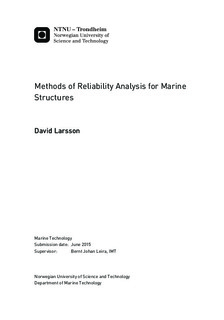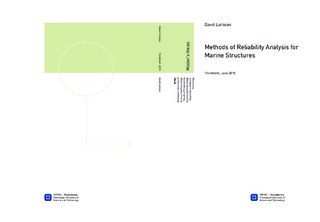| dc.description.abstract | Analytical solutions of structural reliability problems are often tedious or impossible
to obtain. The task is further complicated when the safety margin,
i.e. the relation between variables and response, is implicit. Such is the case
for many practical problems, where structural response is obtained from finite
element models and/or by semi-analytical equations. This thesis describes a
practical approach to solution of such problems by response surface methods,
i.e. ways of approximating the analytical safety margin by sampling at discrete
points. If each such sample is computationally demanding, it is necessary to
limit the number of sampling points without introducing unacceptable lackof-
fit. Theoretically, once the response surface is given, an accurate approximation
of failure probability can then be found by the Crude Monte Carlo
method. However, with low probabilities of failure and/or high dimensionality,
this method becomes computationally unfeasible.
Two response surface methods are tested for a stiffened panel, where the effects
of distribution types are investigated by comparing between more realistic
models and corresponding gaussian approximations. The evaluations are performed
for a stiffened panel based on three different limit states; von-Mises
stress in the plate along the midspan, axial capacity and a check according relevant
classification guidelines. For von-Mises stress and ultimate capacity limit
states, finite element software ABAQUS is used to sample the safety margin.
The third is modelled from Det Norske Veritas recommended practice for buckling
of stiffened panels, corresponding to a check for plate side at midspan. A
purely quadratic response surface as suggested by Bucher and Buorgund [4],
along with a hyperplane based on vector projection as suggested by Kim and
Na [15] are employed. From the quadratic response surface, probability of
failure is evaluated by Crude Monte Carlo, Importance Sampling and a First
Order Reliability method (FORM).
The response surface obtained by vector projection yields similar results as the
quadratic response surface in combination with simulation methods, but with
some deviations. These differences are generally larger for the non-gaussian
case than for the gaussian distributions. From the results, it can not be concluded
whether the differences are method-specific or caused by underlying
calculations, e.g. variable transformations.
Effects of probability distributions are important, and the results with all variables
taken from the gaussian distribution is highly conservative compared to
using more relevant probability densities.
It is shown how the structural reliability problem can be solved for implicit
limit states in a sensible manner. The procedures shown are efficient from a
computational perspective, and the results from both approaches are equivalent.
A difference between the two methods in terms of applicability is noted.
The purely quadratic, "Bucher-Buorgund", response surface samples the safety
margin using two iterations with enough sampling points in each to uniquely
determine the polynomial description, and simulations are used to find the
most accurate probability of failure measure. The Vector Projection approach
samples the safety margin by continuously establishing a hyperplane approximation
and shifting the sampling points until a convergence criteria is met. The
probability of failure is evaluated simultaneously by FORM, which is highly efficient
compared to Monte Carlo. This leads to an unknown, potentially fairly
large, number of safety margin samples but swift probability of failure calculations.
If the results are considered equivalent, it can then be recommended
to use the Bucher-Buorgund approach for problems where the safety margin
samples are computationally demanding but the failure probabilities are moderate,
whereas the Vector Projection approach is feasible for any probability of
failure when the safety margin sampling is fast.
The results in terms of failure probabilities are not thought of as directly applicable
to design but are deemed valid in the sence of highlighting some important
considerations and show the essence of solving similar problems. A valid
starting point for further analysis and design purposes would be to extend the
model with respect to boundary conditions, imperfections and an increased
number of basic variables along with correlation effects. | |

